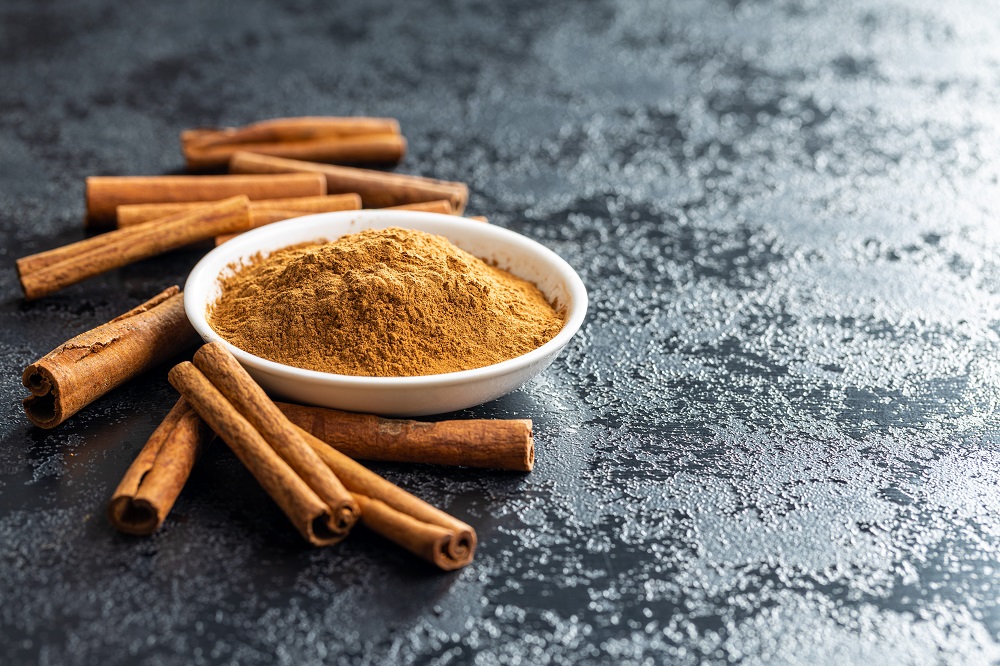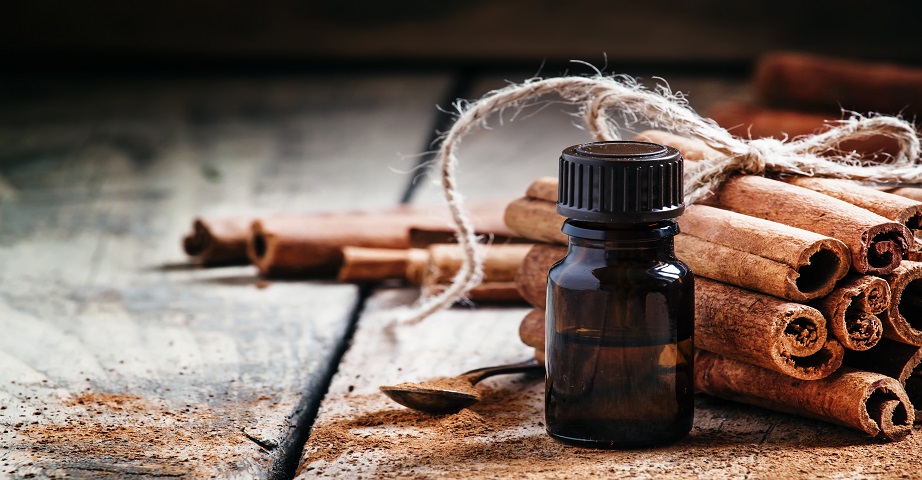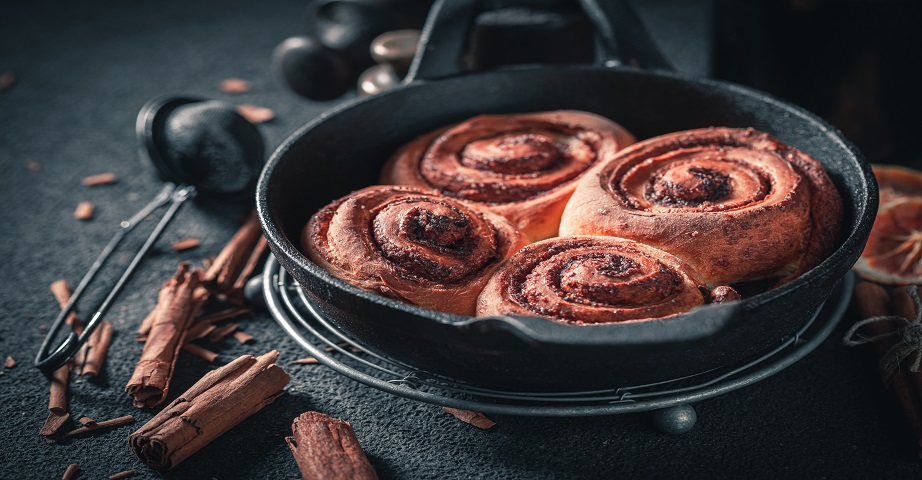Cinnamon - aromatic spice with health-promoting properties

Cinnamon is a spice obtained from dried Cinnamomum bark. It is most often found in the form of a stick or powder. It is distinguished by characteristic sweet and spicy smell and slightly spicy taste, thanks to which it is commonly used as an addition to dishes. However, cinnamon, in addition to organoleptic qualities, also has pro-health properties. How does cinnamon affect the human body? How to apply it? Does cinnamon help with weight loss?
Cinnamon - what is it?
Cinnamon is considered one of the oldest seasoning in the world. It is estimated that it comes from China, where it was known and used already 3 thousand years before our era, but it is difficult to determine exactly who invented a cinnamon. The first mention in herbal books concerning the spice dates back to 2700 BC. In ancient Egypt, the substance was used not only as an addition to dishes, but also as a body preservative, used during embalming and mummification. The Taoists, on the other hand, considered thecinnamon to be the food of the gods and used it as a component of the elixir providing strength. They also thought that carrying the spice with them could prevent any disease.
Today, the cinnamon is an ingredient that can be found in almost every kitchen. The spice is appreciated both for its unique taste and aroma, as well as for its health-promoting properties.
The cinnamon is distinguished by its brown color, strong aroma and sweet and spicy taste, which owes to the presence of cinnamon oil. It is an ingredient obtained from dried bark of a Cinnamomum, a tree from the Lauraceae family, which includes over 250 different plant species, grown in the subtropical climate zone. The most famous representatives of this kind are cinnamon obtained from Cinnamomum verum and Cinnamomum cassia, also called Chinese cinnamon.
Recommended products with cinnamon
Chinese cinnamon and Ceylon cinnamon - differences
The most well-known and appreciated variety of the substance is a Ceylon cinnamon, because other species of the plant are rarely imported to Europe.
A Chinese cinnamon is cheaper and, for the average consumer, difficult to distinguish from cinnamon from Ceylon, which is why it is often falsely sold as Ceylon cinnamon. So it is worth knowing what are the differences between the species of seasonings.
Types of a cinnamon differ from each other in the appearance of a stick - the Ceylon cinnamon resembles a cigar and curls on both sides of the bark, while the Chinese cinnamon is twisted individually. Differences can also be seen when grinding a stick - the Chinese cinnamon is difficult to grind, while the Ceylon cinnamon does not cause any difficulties. Moreover, the substances differ slightly in color - the Chinese cinnamon has a dark, rusty color, while the Ceylon cinnamon - a light brown, light coloration. Small differences can also be felt in the smell and taste of the spices - the Chinese variety is more spicy and aromatic, while the Ceylon has a citrus note. An important difference between substances is also the content of coumarins, or compounds that are attributed to hepatotoxic activity. The Chinese cinnamon may contain about 1% coumarins, while the Ceylon cinnamon may contain about 0.004%. The cinnamon from Ceylon is about 250 times safer than the cinnamon from China.
Cinnamon - what does it contain? Nutritional value of cinnamon
The cinnamon is distinguished by a fairly high energy, but using small amounts of spices every day, you should not worry about it. In 100 g of the product, can be found about 247 kcal, while one teaspoon of the product contains only 10 kcal. In addition, can be found small amounts of protein and carbohydrates in the seasoning, as well as vitamin K and minerals such as iron, magnesium or calcium.
The cinnamon also contains many active compounds and is a source of substances distinguished by high biological activity. In the product can be found polyphenols, such as cinnamic acid, gallic acid or catechins, as well as volatile ingredients. In the Cinnamomum bark are also distinguished coumarins and cinnamaldehyde, which are compounds responsible for the taste and smell of spice.
Cinnamon properties. How does cinnamon affect the body?
Cinnamon has been appreciated for thousands of years not only for its unique taste and aroma, but also for its health-promoting properties. How does cinnamon affect the body?
Cinnamon and diabetes
Scientific research focuses primarily on the effect of cinnamon on blood sugar levels. Previous studies suggest that the use of cinnamon may contribute to the reduction of glycated hemoglobin levels, as well as to the reduction of fasting glucose in the blood.
Although the American Diabetes Association has expressed a position that the cinnamon does not provide health benefits to people suffering from diabetes, many scientific data indicate that the spice may have hypoglycemic properties. The cinnamon aldehyde, the source of which is cinnamon oil contained in the spice, may be particularly effective in lowering blood glucose levels.
Cinnamon and cholesterol
In addition, studies show that regular consumption of the cinnamon can have a positive effect on lowering the level of total cholesterol in the blood serum, as well as contribute to the reduction of LDL cholesterol and triglyceride levels in the blood.
Some data also suggest that the cinnamon may contribute to an increase in HDL cholesterol, but other results contradict these findings. Therefore, further analyses are needed to determine the effect of the spice on HDL cholesterol levels in the blood serum.
Cinnamon and PCOS
Polycystic ovary syndrome is a condition that may be associated with the occurrence of undesirable symptoms associated with metabolic disorders. Scientific data indicate that cinnamon supplementation may have a positive effect on health parameters among women struggling with PCOS.
According to the results of the study, the cinnamon can contribute to a decrease in fasting blood sugar levels, as well as to a decrease in total cholesterol and triglycerides in blood serum. Moreover, it may lower the value of the insulin resistance index (HOMA-IR). There are also data suggesting that the cinnamon may increase the regularity of menstrual cycles.
Other, potential health-promoting properties of cinnamon
There are also publications suggesting that the cinnamon may:
- exhibit anti-inflammatory properties and thus be helpful in the therapy of rheumatoid arthritis (RA), contributing to the reduction of C-reactive protein and TNF-alpha, that is molecules that are found in the human body in excessive amounts during inflammation,
- reduce and relieve menstrual pain and shorten their duration,
- exhibit strong disinfecting effect,
- contribute to weight loss - some data suggest that the cinnamon belongs to thermogenics, which are substances that accelerate metabolism. Animal studies have shown that the cinnamaldehyde can activate a thermogenic reaction in fat cells and contribute to weight reduction, while other data suggest, the cinnamon may help lower BMI. However, there are also results informing that the spice does not have slimming properties, which is why further research is still needed to confirm the effect of cinnamon on weight reduction,
- exhibit antioxidant activity, and thus contribute to neutralizing free radicals and reducing oxidative stress in the body, as well as delay the aging process,
- Favourably affect the intestinal microflora, among others, by increasing the amount of beneficial bacteria in the intestines,
- be helpful in painful stomach cramps, as well as in indigestion and bloating,
- to a slight extent, exhibit blood pressure-lowering properties,
- refresh the breath and neutralize bacteria in the mouth.

Use of cinnamon
Cinnamon is a comprehensive product that can be used both in the kitchen, in the pharmaceutical or cosmetic industries, and even in agriculture. How to use the cinnamon?
Cinnamon - use in the kitchen
The cinnamon is an aromatic seasoning that has a characteristic smell. It works both as an addition to sweet dishes - cakes and pastries, as well as for dry dishes - fish and meats. The substance is often used in the preparation of oatmeal, cocktail or cookies, known as cinnamon rolls.
The cinnamon is also often used as an additive in beverages, such as coffee. Why add cinnamon to coffee? The combination of spice with caffeine can positively affect digestive processes, and can also be helpful in weight reduction.
In addition, the cinnamon can be found among the ingredients of liqueurs, mulled wine, compotes or jams.
Other uses of cinnamon
In addition to the kitchen, the cinnamon is also appreciated in the cosmetics industry, where it is used such as component of cosmetics, among others, creams and lotions, due to its aromatizing properties. The spice is also used in the production of perfumes, as well as toothpastes - the cinnamon oil contained in the product can be helpful in the case of tooth decay and inflammation of the gums.
In addition to cosmetics, the cinnamon is also used in the pharmaceutical industry as a substance that improves the taste and smell of certain drugs. It is also used as an ingredient in preparations that are added to animal feed.
3 quick recipes with cinnamon
Since the cinnamon can have many health-promoting properties, it is worth including it in the daily menu. What quick and tasty dishes can be created with his participation?
Rice on milk with apple and cinnamon
A dish that will be good solution both among the younger and among the older. A dish that will delight the taste buds in the morning as well as in the evening. Rice on milk with apple and cinnamon is a taste of childhood, which is worth returning to regardless of age!
Ingredients: A glass of milk, 100 g of white rice, 1 apple, a teaspoon of honey, half a teaspoon of cinnamon.
Preparation: Boil the milk, add the rice and a tablespoon of honey. Cook until the rice is soft. When the rice is ready, add the cinnamon and mix. Peel the apple, grate it and also add to the rice. Mix all ingredients and transfer into a plate.
Cinnamon rolls - buns with cinnamon
Although it is not the most dietary baking, it is really tasty. Sometimes you can afford such little sins...
The fastest cinnamon rolls can be prepared from ready-made puff pastry. Having a little more time, it is worth considering preparing the dough yourself or creating yeast-based cinnamon. Whichever option you choose, cakes will definitely be delicious! To make your task easier, we present a recipe for a yeast version of the cinnamon rolls.
Ingredients: 120 ml of milk, 25 g of fresh yeast, 250 g of wheat flour, 15 g of sugar, 1 egg, 50 g of butter, 2 teaspoons of cinnamon, 2 teaspoons of vanilla sugar.
Preparation: Heat the milk, add yeast and sugar, and create a leaven. Sift the flour into a bowl, add the egg and the prepared leaven. Knead the dough and leave for half an hour to rise. Roll out the dough and spread with butter. Sprinkle with cinnamon and vanilla sugar and wrap in a roll. Cut across. Ready "snails" lay on a baking tray lined with paper. Bake in an oven preheated to 180 degrees for about 15 minutes until the dough is browned.

Baked apple with cottage cheese and cinnamon
An aromatic snack that tastes the best in winter, eaten by the fireplace, but it will be perfect as a second breakfast or afternoon tea at any time of the year!
Ingredients: 1 apple, 1 teaspoon of cinnamon, 30 g of semi-skimmed cottage cheese.
Preparation: Wash and cut the apple in half, and then drill the core. Mix the cottage cheese with the cinnamon and place inside the halves of the apple. Wrap in aluminium foil and place for 25 minutes in an oven preheated to 200 degrees.
Cinnamon - contraindications and side effects
The American Food and Drug Administration has recognized the cinnamon as a human-safe substance and granted it GRAS status (Generally Recognized as Safe).
Too much cinnamon intake can contribute to nausea and vomiting, as well as excessive sweating. In addition, caution when using the spice should be taken by people struggling with ailments related to the gallbladder and the whole of digestive system - in the cinnamon are present substances, which can affect the properties of bile and the secretion of digestive juices.
Due to the higher content of coumarins in the Chinese cinnamon, it is worth choosing the Ceylon cinnamon, which is distinguished by a lower content of a substance that has toxic and disruptive effects on the liver.
Bibliography:
- https://pubmed.ncbi.nlm.nih.gov/22579946/
- https://pubmed.ncbi.nlm.nih.gov/29046261/
- https://pubmed.ncbi.nlm.nih.gov/26023601/
- https://pubmed.ncbi.nlm.nih.gov/36747357/
- https://pubmed.ncbi.nlm.nih.gov/29737802/
- https://pubmed.ncbi.nlm.nih.gov/24813595/
- https://pubmed.ncbi.nlm.nih.gov/29722610/
- https://pubmed.ncbi.nlm.nih.gov/23867208/

